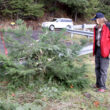Sean C. Morgan
Of The New Era
The South Santiam Watershed Council has received a $50,000 grant to find and begin removal of barriers to fish trying to swim up the river and its tributaries.
The grant money comes from penalties assessed against a firm caught polluting in the Columbia Gorge, Watershed Council Coordinator Eric Hartstein said. Funds from the penalties were used to establish a grant program for environmental projects. The grant, received May 21, will enable the council to inventory fish passage barriers in the watershed and prioritize them for projects to remove the impediments.
A total of eight grants were awarded, Hartstein said. The South Santiam Watershed Council is matching the grant funds with $41,200 provided by the U.S. Bureau of Land Management, part of the timber safety net monies.
The survey will be completed in conjunction with the North Santiam Watershed Council.
“In layman’s terms, we’re trying to find out where the barriers are in the watershed and prioritize those barriers for restoration,” Hartstein said.
The South Santiam Watershed is huge, he said. The grant is generous, but it won’t allow the council to survey the whole watershed.
The Watershed Council knows where some of the barriers are from past surveys, he said. Most of those are on public lands, and they have less of an idea where they are on private lands.
The survey will look mainly at culverts, he said. Culverts create the majority of the fish passage problems in streams.
Often, they are the same culverts that get backed up in the winter, or they are failing culverts, Hartstein said, and finding those and fixing the problem is a win-win.
“I think that’s where watershed councils are effective,” Hartstein said. “It’s not a zero-sum game.”
Using the grant, the council will hire an Oregon State University graduate student in biological and ecological engineering for two years and provide a scholarship or sponsorship in exchange for the student’s work.
The survey will identify the highest priority barriers in the watershed, and the council will receive conceptual designs for removing the barriers, Hartstein said.
“In this watershed, we have two listed species, winter steelhead and spring Chinook,” Hartstein said.
During the winter, young Chinook and steelhead travel up the small tributaries to hide from the rushing winter water, he said, but the barriers can block them. The barriers also can block spawning beds.
The council has several ways to deal with barriers, he said. “It really depends on the shape of the culvert or the barrier.”
Sometimes, that means a bigger culvert, he said, and at other times, it means replacing the culvert with a bridge.
Often, the culverts are undersized, filling up and falling apart when flows are at their highest, Hartstein said. When flows are high, the velocity of the water through an undersized culvert can be an issue too.
Culverts also create “perches,” he said. Those are small jumps where the downstream end of the culvert is higher than the streambed.
Problems with culverts that get full of debris can be solved by replacing them with a larger culvert or bridge too, he said. That also helps remove fish passage barriers.
The project is still in its planning stages, he said, but the council will need volunteers for it and other projects this summer as well as ongoing water quality testing.
Anyone interested may contact the council at 367-5564 for more information.
The Watershed Council has several other projects this summer. Among them, the council will install permanent signs at Yukwah Campground as part of the U.S. Forest Service’s “Respect the Rivers” campaign. The signs talk about fish habitat and the life cycles of the fish that live in the river there.
The council also is going to create some final designs to mitigate the fish passage barrier at the mouth of Ames Creek, Hartstein said. That barrier, where the creek spills down a rocky face into the river, is a natural barrier.
When Green Peter and Foster dams started regulating the South Santiam River, it stopped allowing a back flood up Ames Creek, he said. Now Ames Creek is undercut by the South Santiam. The river bed has been cut down, much lower than the streambed, and it has become an obstacle for steelhead migrating up Ames Creek.
The Watershed Council will use federal funds with money provided by the Oregon Watershed Enhancement Board to complete the designs.
The Watershed Council will likely create a natural fish ladder with resting pools in an old channel that runs between Ames Creek and the city’s wastewater treatment plant, Hartstein said.
The council also will replace a culvert on a Wiley Creek tributary in July on property owned by the Campbell Group of Eugene.





